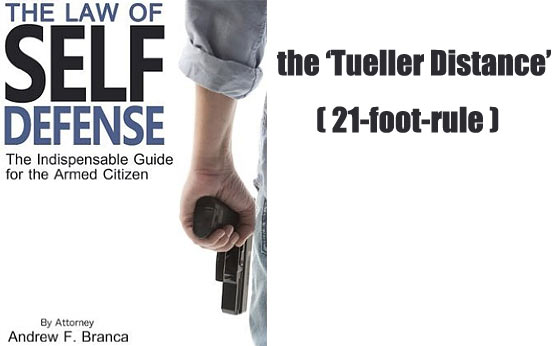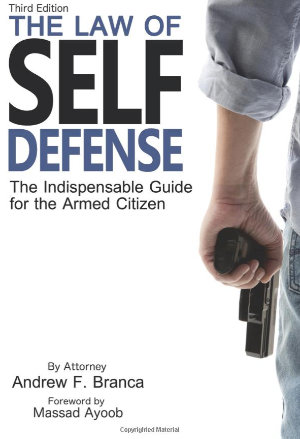21 Foot Rule – Tueller Distance Legal Strategy for a Self Defense Shooting

Have you heard of the “21 foot rule” ? “At what distance is an impact weapon an imminent threat?” asked Dennis Tueller, a now retired Salt Lake City police officer. Is it 5 feet? 10 feet? 15? More?
In other words, at what distance will someone handling a weapon such as a baseball bat or knife (for example) become a potential threat to you?
The 21 Foot Rule – Tueller Distance – And WHY You Need To Know About It
Tueller, also a firearms instructor, proceeded to run a lot of drills on this subject. He wanted to determine how long it takes to get one’s pistol out of a holster to engage a threat. More specifically center-mass hits versus the time it takes for an imminent threat with an impact weapon to get to you.
If you carry a handgun, you need to understand this, for several reasons. One of which is for your own personal self defense. Another, for your legal defense should you ever be involved in a self defense shooting. Here’s why…
The fact is, if you did not know about the 21 foot rule prior to a self defense shooting (sometimes referred as the Tueller rule or distance), the use of this aspect of your defense will NOT be admissible in court. In fact, even if you did know about it, you will likely need to prove that you knew about it (I’ll explain in a moment).
Why is it important to cite the 21 foot rule as part of your defense? Because depending on the incident, it may help prove that there was ‘imminence’ and an imminent threat to your life. This will be one part of your overall defense strategy.
The time it takes to engage with a handgun
Tueller discovered that most police officers are able to get their pistol out of their holster and engage within 1.5 seconds.
The approximate distance of an imminent threat with an impact weapon
Tueller also drilled the distance at which a person can run from a standing start for 1.5 seconds to be about 21 feet.
21 feet became the 21 foot rule, or Tueller distance. That is, the threat (with an impact weapon such as a knife) — their approximate maximum distance away from a police officer for engagement.
Note: If the threat has a gun, then the Tueller distance does not apply, because the threat can shoot you from a much further distance!
The Importance of the 21 Foot Rule for a Legal Defense
Of course there is much more to a valid self defense shooting! And more importantly a self defense shooting that you can survive through the legal system.
However the 21 foot rule is well cited in case law. It is an important distinction to understand and to integrate into one’s defense (and prior actions!).
Following a self defense shooting during the legal process, you (your attorney) will need to prove that you were an innocent party in the confrontation. For example, that you were not the aggressor, or escalated the confrontation.
The next aspect of your defense will be proving there was an imminent threat. If that threat did not have a gun (instead an ‘impact weapon’), it will be exceedingly important to be able to cite the 21 foot rule – Tueller distance. AND to have previously acted in accordance with that rule as part of your defense.
In other words, if you shot someone who you believed to be a threat to your life who had an ‘impact weapon’ from 40 feet away, it will be much, much more difficult if not impossible to prove imminence in court. If you cannot prove imminence, you lose.
On the other hand, if that same threat to your life was coming at you in the vicinity of approximately 21 feet or less, AND you were able to cite the 21 foot rule – Tueller distance – as prior knowledge in your defense, then the knowledge and facts of the Tueller distance will very likely be admissible to the jury. This will help them to understand, and will greatly help your overall defense (although there is much more to your defense than just this).
Proof that you knew about the Tueller Distance BEFORE the event happened
Earlier I said that you might have to prove that you had prior knowledge of the 21 foot rule – Tueller distance. Yes, that will probably be required (you can’t say afterwards that you knew about it). So how can you prove that you knew? And where did you get that information and knowledge?
I very much recommend that anyone who ever carries a handgun to read this book! I have read it, and it is VERY eye-opening and helpful to understand what will happen following a self defense shooting. You should absolutely read and understand the information within the following book written by Attorney Andrew Branca, an internationally recognized expert on self-defense law (the best I’ve ever read on the subject)…
>> The Law of Self Defense: The Indispensable Guide to the Armed Citizen
(view on amzn)

Attorney Branca advises a way to prove that you knew about the 21 foot rule – Tueller distance… Print the receipt, which includes the date, and tuck it in the book. Highlight the section within the book that talks about this rule, and understanding the rest too!
So, you don’t want to spend the money to buy this book for your self defense strategy in the event of a self defense shooting. Then find this information (about the 21 foot rule – Tueller distance – somewhere else, and similarly document that you read about it.
Two more excellent reads if you carry:
(view on amzn)
>> Deadly Force: Understanding Your Right to Self Defense
>> Traveler’s Guide to the Firearm Laws of the Fifty States
I originally published this article several years ago after having read the book. I recently came across it again and will read it again. So I clarified some of the information above and re-posted for your potential interest, should you be one who “carries”.
